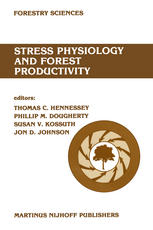Maintaining or increasing stand productivity is the concern of forest land managers worldwide. Consequently, there is increasing interest in understanding the impact of environmental stress on productivity and the development of management strategies that ameliorate or reduce the deleterious effects. Invited scientists gathered in Fort Collins, Colorado on July 30, 1985, to present the current state of knowledge regarding the impact of environmental stress on forest stand productivity. Particular attention was given to elucidating the mode of action by which individual stress elements reduce productivity. Environmental factors and the levels that constitute stressed (suboptimal) conditions in forest stands were identified, and the effects of stress intensity and duration on key stand parameters, including photosynthesis, respiration, assimilate partitioning, senescence and mortality, were emphasized. The role of genetics and silvicultural treatments in lessening the stress impact on stand productivity was presented, particularly in regards to alternative methods for environmental stress management. Modeling of stand dynamics in response to environmental stress was explored as an effective research and management tool. VIII Improved forest management practices will develop as we improve our understanding of the nature of important environmental stresses and as we comprehend their impact on tree and stand performance, manifested through physiological processes and genetic potential. This book is dedicated to such an understanding and comprehension.
Technical
{PDF} Stress physiology and forest productivity: Proceedings of the Physiology Working Group Technical Session. Society of American Foresters National Convention, Fort Collins, Colorado, USA, July 28?31, 1985 S. G. Pallardy (auth.), Thomas C. Hennessey, Phillip M. Dougherty, Susan V. Kossuth, Jon D. Johnson (eds.)
$19.99






Reviews
There are no reviews yet.